-
Membership
Membership
Anyone with an interest in the history of the built environment is welcome to join the Society of Architectural Historians -
Conferences
Conferences
SAH Annual International Conferences bring members together for scholarly exchange and networking -
Publications
Publications
Through print and digital publications, SAH documents the history of the built environment and disseminates scholarship -
Programs
Programs
SAH promotes meaningful engagement with the history of the built environment through its programs -
Jobs & Opportunities
Jobs & Opportunities
SAH provides resources, fellowships, and grants to help further your career and professional life -
Support
Support
We invite you to support the educational mission of SAH by making a gift, becoming a member, or volunteering -
About
About
SAH promotes the study, interpretation, and conservation of the built environment worldwide for the benefit of all
Recap of SAH in Paris: Glass, Light and Structure, May 16-18, 2018
Jun 14, 2018
by
Pauline Saliga, SAH Executive Director
Imagine, if you will, spending two-and-a-half days touring iconic Paris buildings with friends, colleagues, and a professor with both deep subject knowledge and a great sense of humor. Innovative uses of glass, light, and structure provided the conceptual framework for just such a remarkable SAH tour of Paris with Barry Bergdoll, the Meyer Schapiro Professor of Art History and Archaeology at Columbia University.
The program launched with a cocktail reception at a private Parisian apartment on rue Gay Lussac, where our travelers both met one another and renewed old friendships. Good French wine and artisanal local cheese were the bill of fare to begin two days of touring Paris.
The first full day covered Paris, Lille and Lens and began with an in-depth interior tour of Le Corbusier’s Maisons La Roche-Jeanneret (1923–1925), which serve as the headquarters of the Le Corbusier Foundation and were built following the architect’s famous 1922 manifesto on residences and urban form. A nearby stop at the cul-de-sac, rue Mallet Stevens (1926–1927), provided us with an alternate demonstration of an avant-garde manifesto for urban modern architecture. In an abundance of generosity, the Le Corbusier Foundation granted us access to Le Corbusier’s studio space (1931–1932) on the top floor of an eight-story, multi-family dwelling that Le Corbusier designed and lived in for three decades. The studio was in the final stages of a two-year restoration at the time of our visit and is scheduled to open as a publicly-accessible space owned by the Foundation in summer 2018.
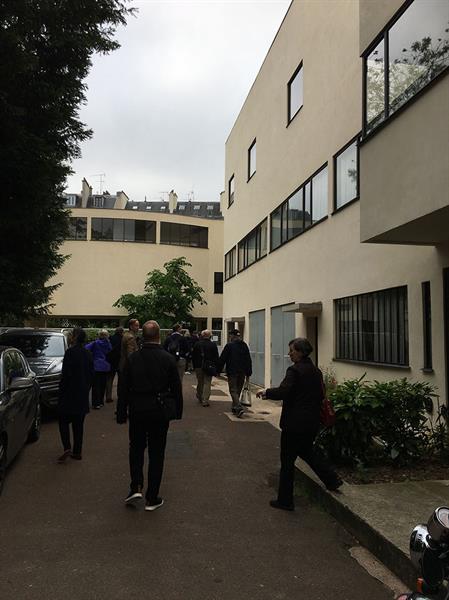
Maison La Roche
An afternoon trip to the north of Paris took us to the recently-restored country estate Villa Cavrois (Robert Mallet-Stevens, designed 1929–1932, built 1930–1932). Possibly inspired by Dutch De Stijl architecture or the Prairie School work of Frank Lloyd Wright, the vast brick estate and its restored gardens are stunning examples of an International Style mansion of the 1930s. On the drive back to Paris we toured the Louvre Lens, designed by SANAA (2006–2012). Responding to the vestiges of the town’s coal mining history, the Japanese architectural firm designed a museum that is notable for both its transparency and reflectivity, making it a subtle insertion into the town’s industrial and residential landscapes. Upon our return to Paris, we enjoyed cocktails and dinner at the Art Nouveau/Art Deco Terminus Nord, one of the many restaurants that opened across the street from Gare du Nord in the nineteenth century, to serve fresh seafood and produce daily, made possible by the French railroad system.
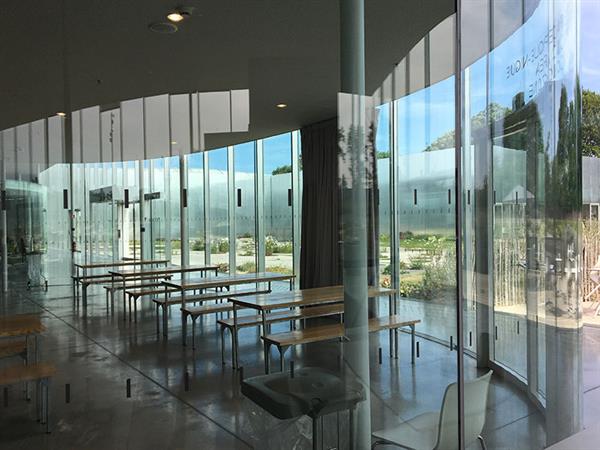
Louvre Lens
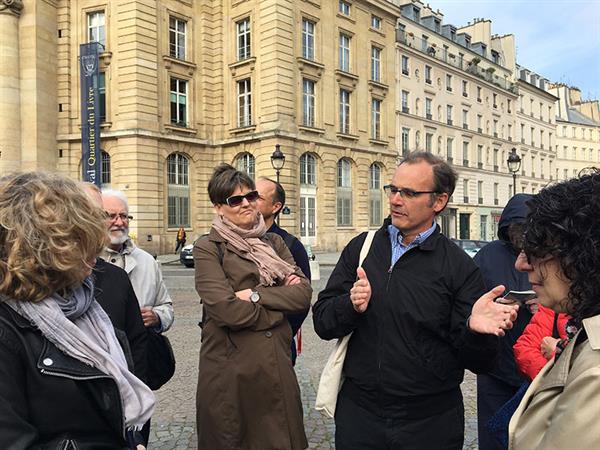
Group at the Place du Pantheon Paris
The second full day of the tour focused on in-depth visits to iconic Paris buildings including the Pantheon, two library reading rooms designed by Henri Labrouste, and the incomparable Maison de Verre. The day began with a tour before public hours of the reading room in Bibliotheque Ste. Genevieve (Henri Labrouste, 1838–1850). The reading room, which takes up the entire upper floor of the library, captures exterior light and diffuses it over a white barrel vaulted ceiling which is supported by a central spine of delicate cast iron columns and spandrels. Walking directly across the street, we discussed in detail the design and significance of the Pantheon (Jacques-Germain Soufflot, originally the Church of Ste. Geneviève, today the Pantheon, 1757–1791). With special permission, we ascended 23 stories, walking above the building’s massive dome and across parapets and foot bridges, to reach the lantern at the very pinnacle of the dome. Weak knees and queasy stomachs were no deterrent.
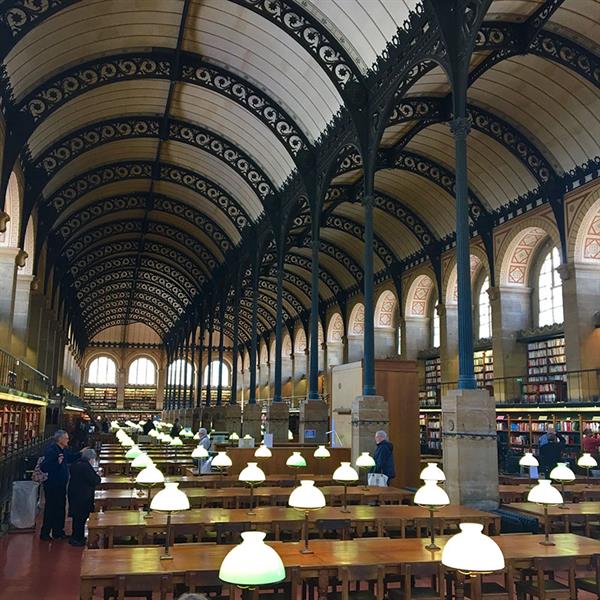
Ste. Genevieve Library
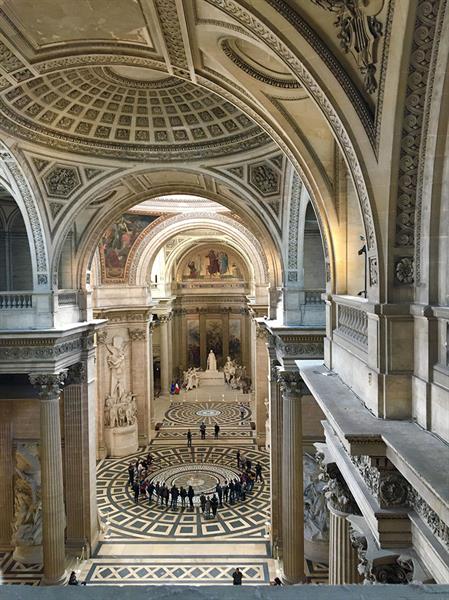
Pantheon arches and dome
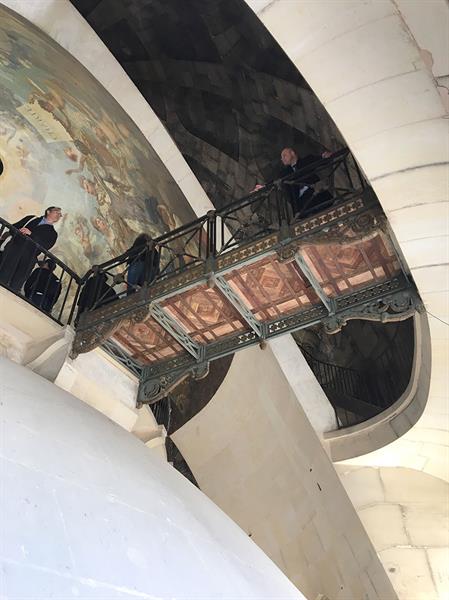
Above the dome in the Pantheon Paris
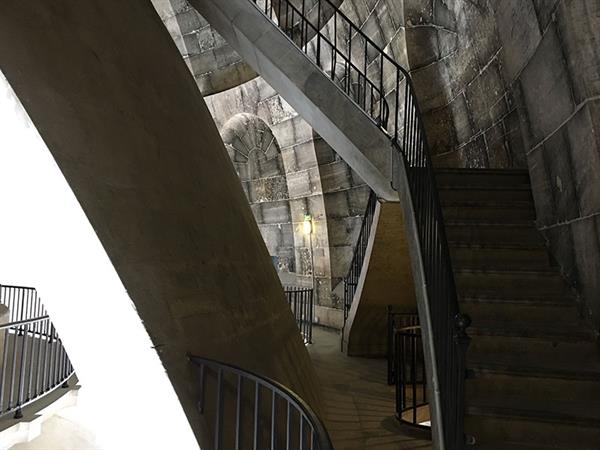
Walkways around the Pantheon dome in Paris
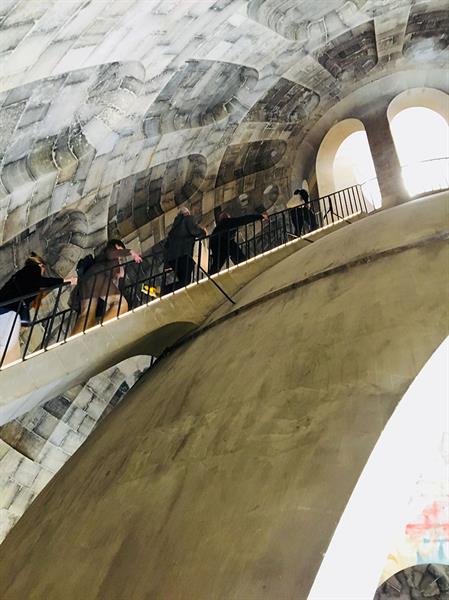
Climbing stairs to access Pantheon lantern
Following lunch in the Passage Vivienne (François-Jacques Delannoy, 1823–26), one of Paris’s little-known glassed shopping arcades, we walked one block to the view the Main Reading Room and Stacks of the former Bibliothèque Nationale, today library of the Institut National d’Histoire de l’Art (Henri Labrouste, 1854–1873). Nothing prepared us for the magnificence of the reading room, topped by a nine-square ceiling grid of glazed enamel vaults, each pierced by a circular skylight of polished glass. Supported by elongated cast iron columns, innovative glass and enamel vaults function as perfect diffusers of daylight for this remarkable reading room.
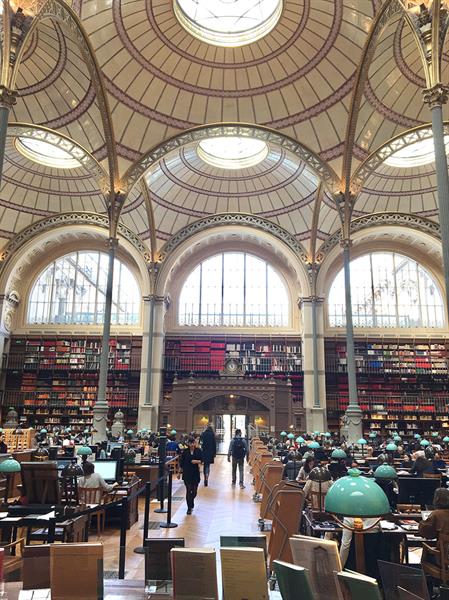
Labrouste Reading Room
The final building of the day and the tour was Maison de Verre (Pierre Chareau, Bernard Bijvoet and Louis Dalbet, 1928–1932). Andrew Ayers, author of the definitive 2003 guide, The Architecture of Paris, and an expert on the history and restoration of Maison de Verre, gave an insightful talk about the history and restoration of the house and the family that commissioned it. Ayers then gave an in-depth tour of every room of this mysterious structure that is equal parts private home/public office, machine/industrial assemblage, and design genius. As planned, we enjoyed cocktails at sunset and dinner at dusk and watched as the character of house shifted as the sun set. It was the pure embodiment of the tour’s theme of glass, light, and structure.
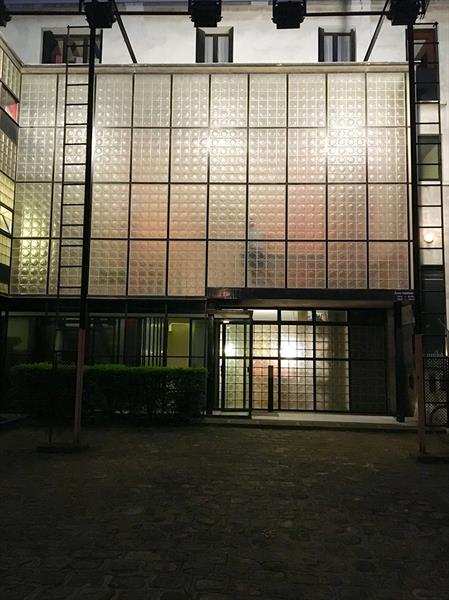
Maison de Verre at dusk
I extend my sincere thanks to Prof. Barry Bergdoll of Columbia University, and Robert Rubin and Stephane Samuel, the generous owners of Maison de Verre, for collaborating with SAH to organize this memorable program. Also, I sincerely thank Barry Bergdoll and all of our French colleagues who made special arrangements for us to tour buildings before opening hours, and who negotiated on our behalf for special access to spaces that are not normally open to visitors. Finally, I thank each everyone who participated in the program for sharing their knowledge, expertise, and critical observations and for walking great distances—sometimes in the rain—to experience the finest architecture in Paris.
The SAH in Paris: Glass, Light and Structure fundraising tour raised $50,000 for two of SAH’s long-term public humanities projects: the print Buildings of the United States publication series and its expanded online edition, SAH Archipedia. Thank you to all who made this event a success.
Pauline Saliga
SAH Executive Director
Barry Bergdoll generously provided additional guidance for those who would be spending time in Paris, which we share below.
Some advice on Paris Book Shops and Guidebooks
The architectural wonders of Paris are too numerous to list, I can only list some favorites. There are many architectural guidebooks to Paris, and many in English editions. To my mind by far the best is that of Andrew Ayers (The Architecture of Paris) first published in 2003. Architectural guide books to Paris are to be found on what might be your first stop upon arriving, the bookstore of the Centre des Monuments Historiques, housed in the Hôtel de Sully, one of the finest surviving Renaissance hôtels in Paris, at 62 rue St. Antoine, Paris 4eme (Marais) at Metro: St. Paul-Le Marais. It is open Tuesdays to Sundays in the afternoon, 1 to 7 pm. A great way to enter it is to go through the doorway in the southwest corner of the Place des Vosges which drops you, quite unexpectedly into the gardens of the Hôtel de Sully. Other excellent bookstores for architecture are the bookstore of the Louvre, located in the passageway between I.M. Pei’s pyramid and the inverted pyramid, same hours as museum, the bookstore of the Musée Carnavalet, which is specialized in the history of Paris, and the bookstore at the Cité de l’Architecture et du Patrimoine, Place du Trocadéro. There is also a nice art and architecture bookstore in the rue Séguier, off the rue St. André des Arts near the Place St. Michel.
Great Walks in Paris
Along the Canal St. Martin, start north from bd. Richard Lenoir. This could be combined with a walk it the most amazing of Haussmann and Alphand’s parks: the Parc des Buttes Chaumont in the 19th arrondissement. You can continue past Ledoux’s Barrière de la Villette towards the Parc de la Villette (Bernard Tschumi)
A walk through the arcades of the Right Bank beginning in the Palais Royal and meandering north.
A stroll through the Cité Universitaire followed by a walk north through the Parc de Monstouris.
Exhibitions of Architectural Interest in Paris in Summer 2018
At the Cité de l’Architecture et du Patrimoine: Alvar Aalto and Henri Pingusson.
You could combine these with visits to related buildings, notably Pingusson’s exquisite and moving Mémorial des Martyrs de la Déportation (Memorial to the Martyrs of the Deportation) of 1962 at the eastern end of the Ile de la Cité. You also can visit the only Alvar Aalto building in France, the Maison Louis Carré at Bazoches. The Cité de l’architecture is offering a shuttle bus on Saturday 16 June: Reservations and information at resa@maisonlouiscarre.fr.
At the Louvre: “France vue du Grande Siècle: Dessins d’Israël Silvestre.”
At the Fondation Catier: Junya Ishigama: Freeing Architecture, one of the most beautiful exhibitions of architecture I have ever seen. Building by Jean Nouvel, bd. Raspail. Metro: Raspail.
At the BNF: Dominique Perrault/La Bibliothèque Nationale de France, Portrait d’un projet, 1998–2018, at the Perrault library which is celebrating its twentieth birthday. Interesting models and films.
At the Pavilion de l’Arsenal: Building Better, Better Living; Buildings for Automobiles; Paris, A City in the Making; and more.


